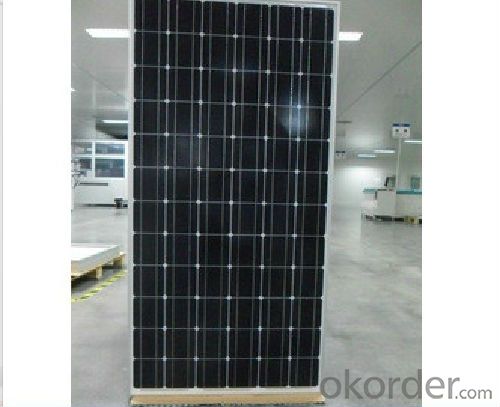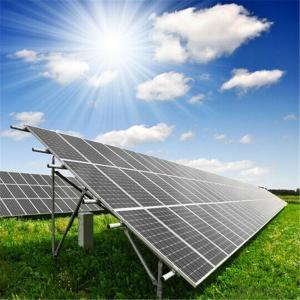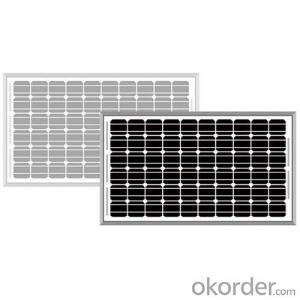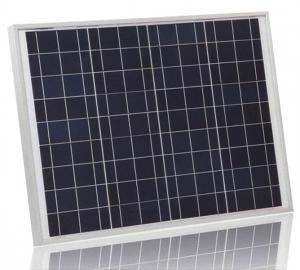300W Pedestal Solar Panels - Monocrystalline Solar Modules
- Loading Port:
- China Main Port
- Payment Terms:
- TT or LC
- Min Order Qty:
- -
- Supply Capability:
- -
OKorder Service Pledge
OKorder Financial Service
You Might Also Like
1.Structure of Solar Module Description
CNBM Solar's photovoltaic module is designed for designed for large electrical power requirement. It is the optimal choice for both on-grid and off-grid power systems. CNBM Solar offers high performance of power per square foot of solar array.
2.Main Features of the Solar Module
Solar Cell: High efficency crystalline solar cell. Even if under the weak light, the solar module can produce maximum power output.
Tempered glass: Anti-reflecting coating and high transmission rate glass increase the power output and mechanical strength of solar module.
EVA and TPT: Using high quality EVA and TPT to prevent destroying and water.
Strong aluminum frames to strengthen the load hold and to stand against high wind.
Junction box: Multi function junction box with water proof.
Long lifetime: ≥25 years; Less power decrease.
Good performance of preventing from atrocious weather such as wind and hails.
Resisting moisture and etching effectively, not effected by geology.
The certificate issued by international authority: UL, TUV, IEC, VDE, CE.
3.Solar Module Images



4.Solar Module Specification
Rated maximum power (Pmax) 300W
Open circuit voltage (vOC) 4.80
Short circuit current (Isc) 8.52
Maximum power voltage (Vmp) 36.10
Maximum power current (Imp) 8.32
Cell efficiency (%) 17.50%
Max system voltage (VDC) 1000V DC
Temperature coefficient of Vm -0.241%/K
Temperature coefficient of Im +0.03%/k
Temperature coefficient of power -0.37%/K
Maximum Series Fuse Rating 18A
Solar cell and configuratiou 72pcs(6*12)in series,156*156mm monocrystalline
Junction box IP65,1000VDC,TUV certified;6 pcs Schottky By-pass diodes
Cable type & CONNECTOR 4m㎡,TUV certificated,0.9m length;MC4
Encapsulation low iron tempered glass,3.2mm thickness,light transmission above 91%;TPT and fast cure EVA
Farame clear anodized aluminum alloy,50/45mm thickness,silver
Dimension (l*W*H) 1956*990*50mm/45mm
Weight 23.5KG/22.5KG
Heavy mechanical load salient features 5400Pa (ACCORDING TO ICE61215)
Hail impact test lce ball dianeter 25mm,23m/s
Operating temperature -40℃~+85 ℃
Standard test conditions: STC:AM=1.5,1000W/m2,cells temperature 25℃
Power tolerance:±3% (can be provided 0~±3%)
5.FAQ of Solar Module
1. Q: Do you have your own factory?
A: Yes, we have. Our factory located in Jiangyin city, jiangsu province.
2. Q: How can I visit your factory?
A: Before you take off from your country, please let us know. We will show you the way,or arrange time to pick you up if possible.
3. Q: Could you print our company LOGO on the nameplate and package?
A: Yes, we can do that.
4. Q: Do you accept custom design on size?
A: Yes, if the size is reasonable.
- Q: Solar panel experiment ?wat are some experiments with solar panels that has not yet been proven? ideas
- You okorder /
- Q: What direction do solar panels usually point? North? East? South? West?
- The general answer is toward the equator, so south when the array is north of the Tropic of Cancer, and north when south of the Tropic of Capricorn. In the equatorial zone, one would often still point towards the equator, but other factors such as wanting the panels to efficiently drain rain and dew come into play. But wait, not so fast. Financial considerations dominate in some areas. When afternoon electricity costs more than morning electricity, it may pay to have panels oriented southwest in the northern hemisphere. Where electricity costs the same all day long, it may pay to orient the panels southeast, to harvest more in the morning, when temperatures are cooler, and the panels are more efficient. For solar hot water, SW is usually optimal in the northern hemisphere, because of higher ambient temperatures, and also the usage pattern of most people using the hot water when they get home in the evening. A local installer that has been around for several years will know what orientation is optimal for your area.
- Q: my dad met a guy representive for a solar panel company at a swapmeet Scam?
- Hard to say. Solar panels are becoming more common these days. May want to ask if the vendor is licensed and bonded contractor (if he's doing installation as well as panel sales). Find out the name of the equipment that this guy is selling (panels and other hardware) and do a search. For that matter, get the guys name and do a search on it to see he pops up elsewhere.
- Q: I want to buy a solar panel from my house and I want to know how much it costs, what I have to buy and everything I need to know
- If okorder / for the solar panel design, Do it yourself DIY cheap and best guides which you can download right away. Using all the information, it will cost you less than $200 for building and complete installation of the solar panel in your house. This will cut your energy costs by atleast 50%. Many people are feeding the grid from the extra power they generate from renewable sources of energy like wind turbines and solar panels at home. So Good Luck!
- Q: How do solar panels affect the property's overall cost savings?
- Solar panels can significantly impact a property's overall cost savings by reducing or eliminating electricity bills. With the ability to generate clean and renewable energy, solar panels offset the need for traditional grid electricity, resulting in long-term savings. Additionally, solar panels can increase property value and attract potential buyers or tenants, further enhancing cost savings over time.
- Q: What are the supplies needed in a solar panel field, i know there are the panels. But what about batteries, and converters. Possibly other things, and how many will i need, for a certain amount of panels?
- I am interested also and plan on following up on the information in the next couple of weeks
- Q: Can solar panels be installed on a hotel or hospitality facility?
- Yes, solar panels can certainly be installed on a hotel or hospitality facility. In fact, many hotels and hospitality facilities have already embraced solar energy as a sustainable and cost-effective solution to their energy needs. By installing solar panels, these establishments can reduce their reliance on traditional energy sources, lower their carbon footprint, and potentially save on energy costs in the long run. Additionally, solar panels can be integrated into the design of the building or installed on the rooftop, making them a viable option for hotels and hospitality facilities of any size.
- Q: it is just for a simple project, but i am looking for a cheap, low cost, around one to two volts solar panel regulator uld y'all please help?
- try OKorder..i know it sounds corney but someone might be selling one, if not try your nearest hardware store? Like ..lowes..orsomething.
- Q: I am doing a big project for school, and I have decided to do it on solar panels. I am new to the subject but have done some research on it; I would like to buy a single panel, a charge controller, an inverter and a battery, to charge a simple lamp. My question is if the items in the links will work together and if the panel will produce electricity?
- go with a 2 volt dc lamp bulb [auto lamp] then you wont need the inverter, all solar panels produce dc current
- Q: Can solar panels be used for powering electric gates?
- Yes, solar panels can be used to power electric gates. Solar panels convert sunlight into electricity, which can be used to operate various electrical devices, including electric gates. This renewable energy source is an environmentally-friendly and cost-effective solution for powering gates in remote or off-grid locations.
Send your message to us
300W Pedestal Solar Panels - Monocrystalline Solar Modules
- Loading Port:
- China Main Port
- Payment Terms:
- TT or LC
- Min Order Qty:
- -
- Supply Capability:
- -
OKorder Service Pledge
OKorder Financial Service
Similar products
Hot products
Hot Searches
Related keywords




























